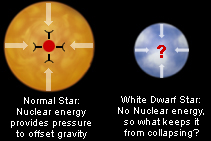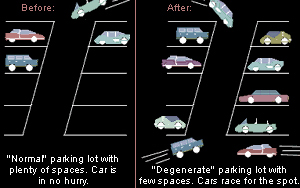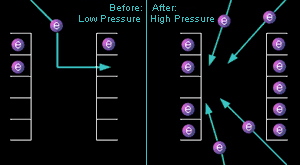|
|
White Dwarfs & Planetary Nebulas
 The paradox was not resolved until the
quantum theory of matter was developed in the 1920s. This theory showed that
matter in so-called "degenerate" states of extremely high density could produce a
new type of pressure never observed in a terrestrial laboratory. This is because
the quantum theory prohibits more than one electron from occupying the same
energy state. The paradox was not resolved until the
quantum theory of matter was developed in the 1920s. This theory showed that
matter in so-called "degenerate" states of extremely high density could produce a
new type of pressure never observed in a terrestrial laboratory. This is because
the quantum theory prohibits more than one electron from occupying the same
energy state.
 To see how this works, think about a
parking lot. Only one car is allowed per space. When there are many empty spaces,
there is very little motion in the parking lot. As an occasional car enters the
lot it is quickly parked. When the parking lot is full, however, the picture
changes. There is continual motion as cars move from one row to another while
drivers search for a space. The pressure builds to get into position whenever a
space is opened up. To see how this works, think about a
parking lot. Only one car is allowed per space. When there are many empty spaces,
there is very little motion in the parking lot. As an occasional car enters the
lot it is quickly parked. When the parking lot is full, however, the picture
changes. There is continual motion as cars move from one row to another while
drivers search for a space. The pressure builds to get into position whenever a
space is opened up.
 Extremely dense matter is like a crowded parking lot. All of the
low energy "parking spaces" are taken, so electrons are forced into higher energy
states, not because they are hot, but because there is nowhere else to go. This
creates a "degenerate" electron pressure (degenerate refers, not to the moral
character of the electrons, but to the
fact that all the low energy states are occupied). This pressure is what prevents
white dwarf stars from collapsing under their own weight. Extremely dense matter is like a crowded parking lot. All of the
low energy "parking spaces" are taken, so electrons are forced into higher energy
states, not because they are hot, but because there is nowhere else to go. This
creates a "degenerate" electron pressure (degenerate refers, not to the moral
character of the electrons, but to the
fact that all the low energy states are occupied). This pressure is what prevents
white dwarf stars from collapsing under their own weight.
Chandrasekhar
Limit
While still in his twenties Subrahmanyan Chandrasekhar, the Chandra X-ray
Observatory's namesake, used relativity theory
and quantum mechanics to show that degenerate electron pressure can do only so
much. If the mass of the white dwarf becomes greater than about 1.4 times the
mass of the Sun—called the Chandrasekhar limit—it will collapse. In a
binary star
system this could happen if a nearby companion star dumps enough material
onto a white dwarf to push it over the Chandrasekhar limit. The resulting
collapse and explosion of the white dwarf is believed to be responsible for the
so-called Type Ia
supernovas.
|
 The paradox was not resolved until the
quantum theory of matter was developed in the 1920s. This theory showed that
matter in so-called "degenerate" states of extremely high density could produce a
new type of pressure never observed in a terrestrial laboratory. This is because
the quantum theory prohibits more than one electron from occupying the same
energy state.
The paradox was not resolved until the
quantum theory of matter was developed in the 1920s. This theory showed that
matter in so-called "degenerate" states of extremely high density could produce a
new type of pressure never observed in a terrestrial laboratory. This is because
the quantum theory prohibits more than one electron from occupying the same
energy state. To see how this works, think about a
parking lot. Only one car is allowed per space. When there are many empty spaces,
there is very little motion in the parking lot. As an occasional car enters the
lot it is quickly parked. When the parking lot is full, however, the picture
changes. There is continual motion as cars move from one row to another while
drivers search for a space. The pressure builds to get into position whenever a
space is opened up.
To see how this works, think about a
parking lot. Only one car is allowed per space. When there are many empty spaces,
there is very little motion in the parking lot. As an occasional car enters the
lot it is quickly parked. When the parking lot is full, however, the picture
changes. There is continual motion as cars move from one row to another while
drivers search for a space. The pressure builds to get into position whenever a
space is opened up. Extremely dense matter is like a crowded parking lot. All of the
low energy "parking spaces" are taken, so electrons are forced into higher energy
states, not because they are hot, but because there is nowhere else to go. This
creates a "degenerate" electron pressure (degenerate refers, not to the moral
character of the electrons, but to the
fact that all the low energy states are occupied). This pressure is what prevents
white dwarf stars from collapsing under their own weight.
Extremely dense matter is like a crowded parking lot. All of the
low energy "parking spaces" are taken, so electrons are forced into higher energy
states, not because they are hot, but because there is nowhere else to go. This
creates a "degenerate" electron pressure (degenerate refers, not to the moral
character of the electrons, but to the
fact that all the low energy states are occupied). This pressure is what prevents
white dwarf stars from collapsing under their own weight.